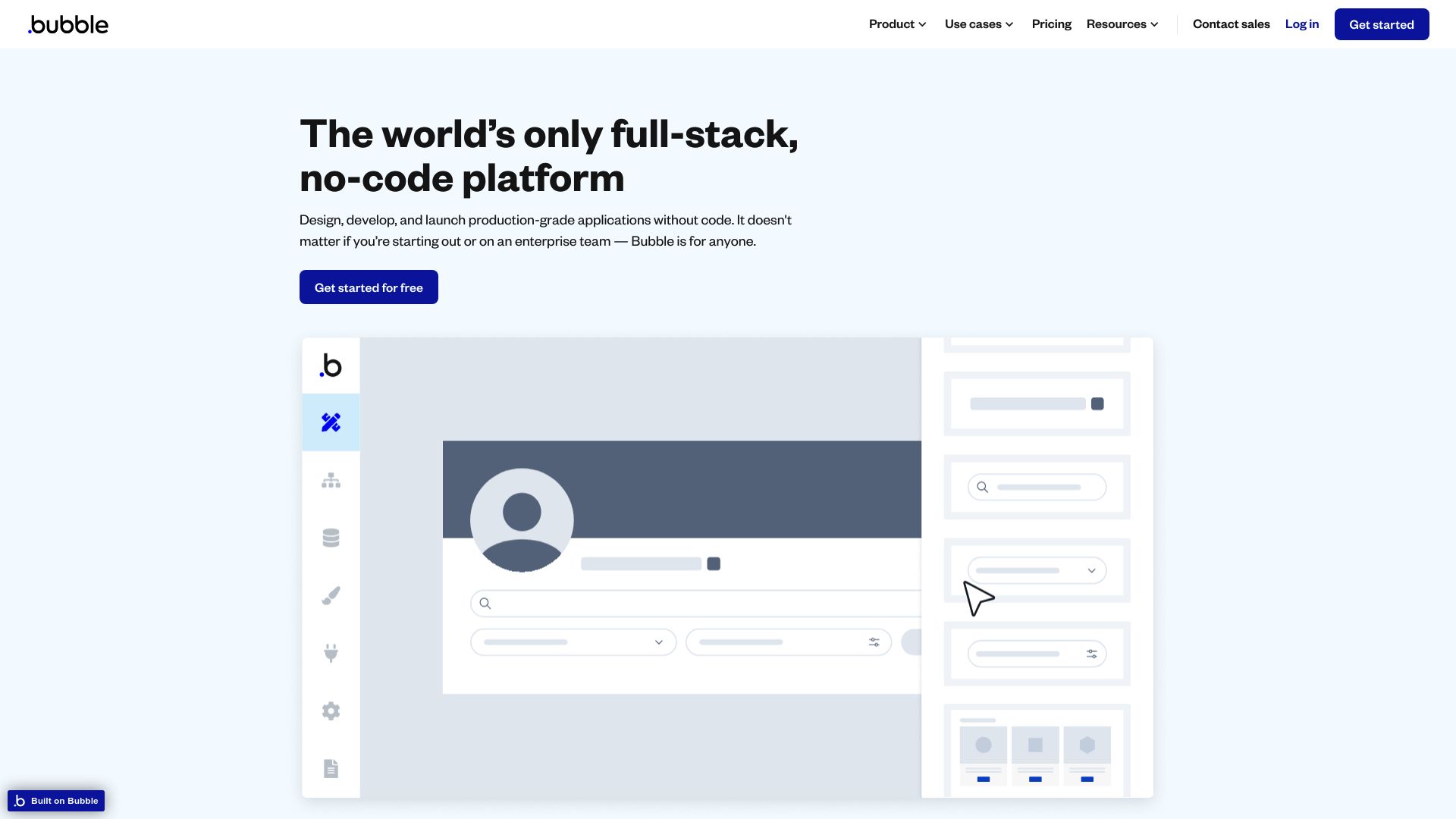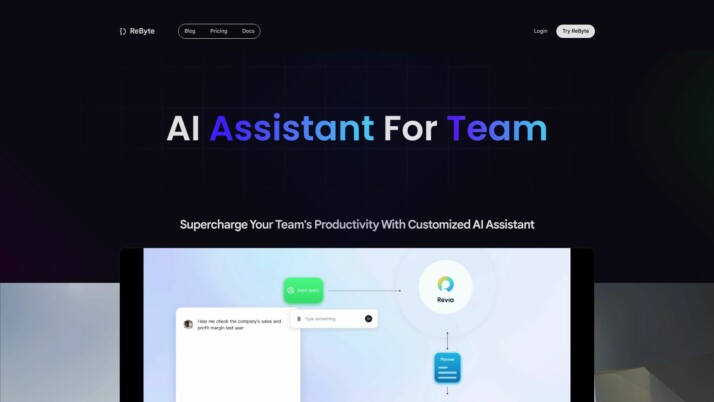Bubble vs. Rebyte: AI Development Platforms Compared
AI development platforms are transforming how businesses create intelligent applications. This comparison examines Bubble vs. Rebyte, and SmythOS — three distinct approaches to building AI-powered solutions. Bubble offers no-code web app creation with AI integration capabilities.
Rebyte provides visual tools for constructing AI agents without extensive coding. SmythOS delivers a comprehensive platform for developing and deploying sophisticated AI systems at scale. We’ll explore each platform’s key features, strengths, and limitations to help you choose the right tool for your AI development needs. Whether you’re a startup founder, enterprise developer, or AI enthusiast, this guide will illuminate the unique capabilities of these powerful platforms.
Bubble Overview
Bubble empowers users to create web applications without writing code. Its visual interface allows dragging and dropping elements to build fully functional websites and apps. Bubble caters to entrepreneurs, small businesses, and enterprises looking to rapidly prototype and launch digital products.


The platform shines in its ability to integrate AI capabilities. Users can connect to services like OpenAI’s GPT models through plugins and API connectors, enabling AI-powered features such as chatbots and content generation. This opens doors for creating sophisticated applications that leverage artificial intelligence without deep technical expertise.
Bubble’s strength lies in its balance of power and accessibility. The visual editor supports complex logic and workflows, allowing intricate app functionality.
Bubble’s strength lies in its balance of power and accessibility. The visual editor supports complex logic and workflows, allowing intricate app functionality. Meanwhile, the no-code approach makes it approachable for non-developers. The platform scales to handle growing user bases, built on Amazon Web Services infrastructure.
While Bubble excels at web app creation, it lacks some specialized AI agent features. The platform doesn’t offer built-in hosted AI agents or autonomous agent capabilities. Users looking for advanced AI-specific tools like explainability features or multi-agent collaboration may find Bubble’s offerings limited in those areas.
Despite these limitations, Bubble’s robust ecosystem of plugins and integrations provides flexibility. The platform’s visual development approach, coupled with its AI integration capabilities, positions it as a powerful tool for rapidly bringing AI-enhanced web applications to life.
Rebyte Overview
Rebyte empowers users to create AI-powered applications without extensive coding skills. The platform offers a visual agent builder for constructing customizable AI agents with multiple steps using large language models. Users can design complex backend logic and create fully customized user interfaces without writing code.


Rebyte’s key strengths lie in its integration capabilities, detailed observability, and serverless runtime designed for production deployment and scaling of agents. The platform manages the entire lifecycle of AI applications, from development to deployment, with minimal manual coding required.
Rebyte empowers users to create AI-powered applications without extensive coding skills. The platform offers a visual agent builder for constructing customizable AI agents… using large language models.
The platform caters to a wide range of users, from developers seeking API integrations to non-technical professionals looking for no-code solutions. Rebyte’s focus on end-user programming through AI aligns with its vision of democratizing AI-powered tool development.
While Rebyte offers robust features for AI application development, it lacks some advanced capabilities found in other platforms. The absence of hosted vector databases, sitemap crawlers, and specialized features like YouTube transcript crawling may limit its utility for certain use cases. Additionally, Rebyte does not provide explicit support for multi-agent collaboration or advanced explainability features, which could be important for some enterprise applications.
Despite these limitations, Rebyte’s emphasis on visual building, integrated runtime, and accessibility makes it a compelling option for users looking to rapidly prototype and deploy AI-powered applications. The platform’s ability to connect with private data sources and provide detailed insights into agent operations enhances its appeal for businesses seeking to leverage AI for productivity gains and workflow automation.
Feature Comparison
Bubble and Rebyte offer distinct approaches to application development, with key differences in their AI and agent capabilities. Bubble excels in no-code web application development but lacks dedicated AI agent features. Its visual interface allows users to create complex web apps without coding, integrating AI functionalities through APIs and plugins. However, Bubble does not provide native support for hosted AI agents, autonomous operations, or advanced AI-specific tools like explainability features.
Rebyte, on the other hand, focuses more directly on AI-powered application development. It offers a visual agent builder for creating customizable AI agents using large language models, enabling complex backend logic without coding. Rebyte provides detailed observability into agent operations and a serverless runtime for production deployment. However, it lacks some advanced features like hosted vector databases, multi-agent collaboration, and specialized crawling capabilities.
In terms of core components, Bubble’s strength lies in its extensive API integrations and robust logic-building capabilities for web applications. Rebyte offers more AI-centric features but may have limitations in certain areas like data lake support or advanced security measures. Both platforms aim to democratize application development, but Rebyte’s focus on AI agents provides a more specialized toolset for AI-driven solutions.
Feature Comparison Table
| Bubble | Rebyte | SmythOS | |
|---|---|---|---|
| CORE FEATURES | |||
| Memory & Context | ❌ | ✅ | ✅ |
| Autonomous Agents | ❌ | ❌ | ✅ |
| Explainability & Transparency | ❌ | ✅ | ✅ |
| Multimodal | ❌ | ❌ | ✅ |
| Multi-Agent Collaboration | ❌ | ❌ | ✅ |
| Bulk Work | ❌ | ✅ | ✅ |
| Agent Work Scheduler | ❌ | ✅ | ✅ |
| SECURITY | |||
| Constrained Alignment | ❌ | ❌ | ✅ |
| Data Encryption | ✅ | ❌ | ✅ |
| OAuth | ✅ | ❌ | ✅ |
| IP Control | ❌ | ❌ | ✅ |
| COMPONENTS | |||
| Huggingface AIs | ❌ | ❌ | ✅ |
| Classifiers | ❌ | ❌ | ✅ |
| Logic | ✅ | ❌ | ✅ |
| Data Lakes | ✅ | ❌ | ✅ |
| DEPLOYMENT OPTIONS (EMBODIMENTS) | |||
| Deploy as API | ❌ | ✅ | ✅ |
| Deploy as Webhook | ✅ | ❌ | ✅ |
| Staging Domains | ✅ | ❌ | ✅ |
| Production Domains | ✅ | ❌ | ✅ |
| API Authentication (OAuth + Key) | ✅ | ❌ | ✅ |
| Deploy as Scheduled Agent | ❌ | ❌ | ✅ |
| DATA LAKE SUPPORT | |||
| Hosted Vector Database | ❌ | ✅ | ✅ |
| Sitemap Crawler | ❌ | ❌ | ✅ |
| YouTube Transcript Crawler | ❌ | ❌ | ✅ |
| URL Crawler | ❌ | ❌ | ✅ |
Best Alternative to Bubble and Rebyte
SmythOS stands out as the superior alternative to Bubble and Rebyte, offering a comprehensive AI agent development platform that combines ease of use with powerful features. We’ve designed SmythOS to address the limitations of other platforms while providing unparalleled flexibility and scalability for AI agent creation.
Our drag-and-drop interface simplifies the process of building complex AI workflows, making it accessible to users with varying levels of technical expertise. Unlike Bubble’s focus on general web application development or Rebyte’s limited AI agent capabilities, SmythOS specializes in creating sophisticated AI agents that can handle a wide range of tasks autonomously.
SmythOS excels in areas where Bubble and Rebyte fall short. We offer advanced features like multi-agent collaboration, allowing teams of AI agents to work together on complex problems. Our platform supports multimodal interactions, enabling agents to process and respond to various types of data, including text, images, and voice. These capabilities far surpass the limited AI integrations of Bubble or the basic agent building features of Rebyte.
SmythOS excels in areas where Bubble and Rebyte fall short. We offer advanced features like multi-agent collaboration, allowing teams of AI agents to work together on complex problems.
Security and scalability are paramount in SmythOS. We provide robust data encryption, OAuth integration, and IP control features that are essential for enterprise-level deployments. Our platform scales effortlessly to meet growing demands, supporting both development and production environments with ease. This level of security and scalability is not matched by either Bubble or Rebyte, making SmythOS the ideal choice for businesses of all sizes.
With SmythOS, users gain access to a vast ecosystem of AI models, including integration with Hugging Face and other leading AI providers. Our platform offers unparalleled deployment flexibility, allowing agents to be deployed as APIs, webhooks, scheduled tasks, or even as ChatGPT plugins. This versatility, combined with our extensive data handling capabilities and support for various file formats, positions SmythOS as the most comprehensive and powerful AI agent builder in the market, surpassing both Bubble and Rebyte in functionality and ease of use.
Conclusion
Bubble, Rebyte, and SmythOS each offer unique approaches to application development and AI integration. Bubble excels in no-code web app creation, allowing users to build complex applications without coding. Its visual interface and extensive plugin ecosystem make it accessible for entrepreneurs and small businesses. Rebyte focuses on AI-powered applications, providing a visual agent builder and serverless runtime for rapid prototyping and deployment of AI solutions.
However, SmythOS stands out as the superior choice for those seeking comprehensive AI agent development and deployment. We offer unparalleled flexibility with our “Create Once, Deploy Anywhere” approach, allowing users to build agents that seamlessly integrate across multiple platforms. Our drag-and-drop interface, coupled with support for over 300,000 integrations, empowers users to create sophisticated AI workflows without extensive coding knowledge.
Unlike Bubble and Rebyte, SmythOS provides advanced features such as multi-agent collaboration, explainability tools, and support for a wide range of AI models. We also offer robust security measures, scalability, and detailed monitoring capabilities, making us ideal for enterprise-level deployments. Our platform not only democratizes AI development but also provides the tools necessary for complex, production-ready AI solutions.
To experience the power of SmythOS for yourself, we invite you to create a free SmythOS account. With our risk-free trial offering unlimited agents and a 30-day money-back guarantee, you can explore the future of AI automation without commitment. Discover our diverse range of AI-powered agent templates to jumpstart your projects, or dive into our comprehensive documentation to unlock the full potential of our platform. Join us in revolutionizing AI development and deployment – your journey towards effortless AI integration starts here.
Last updated:
Disclaimer: The information presented in this article is for general informational purposes only and is provided as is. While we strive to keep the content up-to-date and accurate, we make no representations or warranties of any kind, express or implied, about the completeness, accuracy, reliability, suitability, or availability of the information contained in this article.
Any reliance you place on such information is strictly at your own risk. We reserve the right to make additions, deletions, or modifications to the contents of this article at any time without prior notice.
In no event will we be liable for any loss or damage including without limitation, indirect or consequential loss or damage, or any loss or damage whatsoever arising from loss of data, profits, or any other loss not specified herein arising out of, or in connection with, the use of this article.
Despite our best efforts, this article may contain oversights, errors, or omissions. If you notice any inaccuracies or have concerns about the content, please report them through our content feedback form. Your input helps us maintain the quality and reliability of our information.
